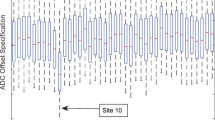Abstract
This paper describes a new fault localization method that is based on the analysis of power supply transient signals. Impulse response functions derived from the power grid are used to de-construct the measured power port transient signals into a set of gate level transients generated by the logic gates as signals propagate along paths in the circuit. By comparing these gate transients with those obtained from a defect-free chip or simulation model, it is possible to identify anomalies produced by defects and to locate them to specific path segments in the layout. Impulse response functions are used to significantly reduce both the attenuation effects of the power grid on the gate-generated transients and the chip-to-chip impedance variations in the power grid and test environment. Non-linear calibration techniques are proposed to reduce the chip-to-chip variations in path delays introduced by process variations. The procedure is demonstrated using simulation experiments to locate the position of defects to one or a small group of gates.




















Similar content being viewed by others
Notes
Power grid characterization is previously discussed in [17] and briefly discussed here for ease of reference.
Current transients are analyzed in this paper, but the same model and procedure holds for voltage transient analysis.
Only one RC model of the power grid needs to be extracted from the layout, e.g., using the nominal values of the process. Process variations are handled by a separate procedure.
The scan chain is not shown in Fig. 3b. It connects the calibration circuits used in each approach together to implement a shift register.
This process is repeated for other gates along the path.
The normalization process accounts for current step variations that occur in the CCs of the CUT due to process variations.
Fan-out was added to improve the accuracy of the modeling of an actual circuit path.
References
Acharyya D, Plusquellic J (2004) Calibrating power supply signal measurements for process and probe card variations. Workshop on Current and Defect Based Testing, pp 23–30
Aitken RC (1992) A comparison of defect models for fault location with IDDQ measurements. ITC, pp 778–787
Bhunia S, Roy K, Segura J (2002) A novel wavelet transform based transient current analysis for fault detection and localization. DAC, 2002, pp 361–366
Chakravarty S, Liu M (1992) IDDQ measurement based diagnosis of bridging faults. JETTA 3:377–385
de Paul I, Rosales M, Alorda B, Segura J, Hawkins C, Soden J (2001) Defect oriented fault diagnosis for semiconductor memories using charge analysis, theory and experiments. VLSI Test Symposium pp 286–291
Gattiker AE, Maly W (1997) Current signatures: application. ITC, pp 156–165
Gong Y, Chakravarty S (1995) On adaptive diagnostic test generation, ICCAD, pp 181–184
Isern E, Figueras J (1995) IDDQ test and diagnosis of CMOS circuits. Des Test Comput 12(4):60–67
Lavo DB, Larrabee T., Colburn JE (1999) Eliminating the Ouija(R) Board: Automatic Thresholds and Probabilistic IDDQ Diagnosis. ITC, pp 1065–1072
Muhammad K, Roy K (2001) Fault detection and location using IDD waveform analysis. Des and Test Comput 18(1):42–49
Naik S, Maly W (1993) Computer-aided failure analysis of VLSI circuits using IDDQ testing. VLSI Test Symposium, pp 106–108
Plusquellic J, Acharyya D, Tehranipoor M, Patel C (2006) Triangulating to a defect’s physical coordinates using multiple supply pad IDDQs: test chip results. International Symposium on Testing and Failure Analysis, Nov., pp 36–45
Plusquellic J, Acharyya D, Singh A, Tehranipoor M, Patel C (2006) Quiescent-signal analysis: a multiple supply pad IDDQ method. Des Test Comput 23(4):278–293 April
Pomeranz I, Reddy SM (1992) On the generation of small dictionaries for fault location. ICCAD, pp 272–279
Singh A, Patel C, Plusquellic J (2004) Fault simulation model for iDDT testing: an investigation. VLSI Test Symposium, pp 304–310
Thibeault C, Boisvert L (1998) Diagnosis method based on delta IDDQ probabilistic signatures: Experimental Results, ITC, pp 1019–1026
van Genderen A, van der Meijs N, Beeftink F, Elias P, Geigenmuller U, Smedes T (1996) SPACE, Layout to Circuit Extraction software module of the Nelsis IC Design System”, Delft University of Technology, (space@cas.et.tudelft.nl)
Wiener N (1949) Extrapolation, interpolation, and smoothing of stationary time series. Wiley, New York
Author information
Authors and Affiliations
Corresponding author
Additional information
Responsible Editor: M. Margala
Rights and permissions
About this article
Cite this article
Rad, R.M., Plusquellic, J. A Novel Fault Localization Technique Based on Deconvolution and Calibration of Power Pad Transients Signals. J Electron Test 25, 169–185 (2009). https://doi.org/10.1007/s10836-008-5092-0
Received:
Accepted:
Published:
Issue Date:
DOI: https://doi.org/10.1007/s10836-008-5092-0




